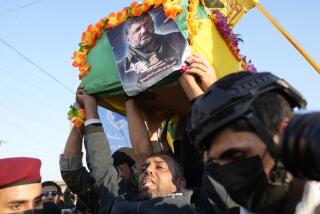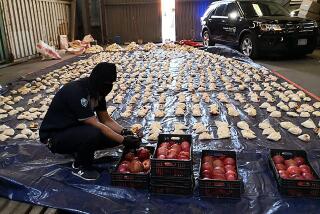U.S. shifts Syria strategy to ‘southern front’
IRBID, Jordan — The Free Syrian Army commander, head of a moderate rebel force fighting just across the border in southern Syria, watched helplessly for months as better-funded Islamist militant groups peeled off half the 2,000 fighters from his brigade.
That changed in February when an intelligence operative from a country he refuses to name handed him an envelope full of cash — salaries for his remaining combatants.
“It’s a good amount of money; I can keep my fighters,” the commander said, as scented smoke from his arghileh [water pipe] obscured a scar across his face, the product of a battle in Syria, just 16 miles north of this drab Jordanian town.
In recent months, Syria’s so-called “southern front” has become the focus of a reinvigorated U.S.-backed initiative to bolster faltering opposition forces now losing ground in their three-year battle to overthrow Syrian President Bashar Assad.
With peace talks stalled and a pronounced slide toward Islamist militancy in the rebel ranks elsewhere across Syria, Washington and allied foreign governments are increasingly concentrating on helping insurgents based in southern Syria. Northern Jordan has become the staging ground.
It is here that U.S. officials and their Persian Gulf allies, notably Saudi Arabia and the United Arab Emirates, are recalibrating their approach in what many view as a last chance to turn around the civil war that has begun to tilt heavily in favor of Assad. But such a strategy could prove too little too late, the type of intra-rebel clashes that have come to define the opposition in northern and eastern Syria has already begun to wreak havoc in the south.
The foreign powers are hoping to re-energize what remains of the U.S.-backed Free Syrian Army as a “moderate” alternative to extremists with such groups as Al Qaeda-affiliated Al Nusra Front — deemed a terrorist organization by Washington — that seek to impose militant Islamic rule.
The cash-stuffed envelopes meant to secure the loyalty of rebel fighters are an essential component of the embryonic southern campaign, according to interviews in Jordan with opposition commanders. All insisted on anonymity because they were not authorized to speak about operational matters.
“Every rebel and activist is looking to the much-vaunted southern front for good news and restored hope,” said Joshua Landis, director of the Center for Middle East Studies at the University of Oklahoma.
Opposition strategists have long viewed the south as a potential backdoor means of attacking Damascus, the Syrian capital, only 75 miles from the Jordan border. The area is also close to Israel, which, like Jordan, is alarmed about a growing extremist presence on its frontier.
But the revamped strategy also appears to have as much to do with counter-terrorism – battling the rise of Islamic militants — as ousting Assad.
West-backed rebel commanders have accused Al Nusra forces of launching a wave of assassinations and kidnappings against Free Syrian Army rivals in southern Syria. Last week, according to rebels here, Al Nusra fighters kidnapped and executed a low-level battalion leader, Fadi Qarqamas, who they accused of colluding with the government.
The killing prompted FSA commanders to convene to decide whether they would now be forced to fight Al Nusra as well as the Assad government. The Islamic State of Iraq and Syria, the ultra-fundamentalist Al Qaeda spinoff group that holds sway elsewhere in Syria, is largely absent in the south.
“We are now convinced that Nusra Front in the south is like ISIS in the north,” one commander said, noting how the Islamic State faction has shifted its focus to dominating rival rebel brigades.
Though cash has begun to flow, southern commanders say they have yet to witness a significant influx of armaments, especially the portable anti-aircraft missiles that rebels in the north have long sought to counter Syrian government air power. U.S. officials fear that such weaponry could fall into the hands of Islamist militants, who could target civilian airliners.
“We think weapons supplies are imminent,” one FSA commander said, “but so far nothing has come through.”
Irbid, traditionally a major crossing point for Syrian-made textiles and foodstuffs, has been transformed into a rebel staging hub and rest area along the more than 200-mile border.
Southern rebel commanders have aggressively marketed themselves to potential Western patrons as the “moderate” variant favored by Washington. That is so despite the increasingly heavy presence of Al Nusra Front guerrillas and Jordanian insurgents, including followers of Abu Musab Zarqawi, the late Al Qaeda icon and Jordanian national long a scourge of U.S. forces in Iraq.
“The idea is that the southern front must have a moderate point of view, not extremist,” another battalion commander said.
FSA southern commanders have complained that foreign support they receive is meager compared to the cash, arms and other assistance flowing regularly to Damascus from Tehran and Moscow, Assad’s major foreign benefactors. They dismiss as inadequate the periodic weapons shipments from Jordan and the U.S. paramilitary training reportedly provided to hundreds of rebels on Jordanian soil.
“Why isn’t the West helping us?” is the oft-repeated refrain of Col. Ahmad Nemeh, head of the Free Syrian Army’s Supreme Military Council in Dara. “Do they want us to turn to extremists?”
Rebel chiefs also downplay the effect of a “Joint International Operations Room” in Amman, Jordan, an opposition nerve center reportedly staffed with operatives of the Central Intelligence Agency and regional allies.
(The CIA declines to comment on reports that the agency is training rebels in Jordan, but current and former U.S. officials say agency operatives train opposition fighters and also coordinate intelligence with them.)
The shift to the south, according to a logistics support officer attached to a southern rebel brigade, became apparent in mid-February, when foreign intelligence liaisons summoned the leaders of about 50 factions to the intelligence center. They were directed to join a new umbrella opposition group branded simply the “Southern Front,” the logistics officer said.
Brigade leaders were instructed to provide rosters of fighters for accounting purposes, the support officer explained. The insurgents would then receive cash payments to cover the salaries, according to the officer’s account. Each participating unit would still retain its own commander and autonomy, but all would coordinate on the battlefield, the rebels were told.
“We wrote down the information of each fighter, with pictures of their brigade IDs,” said the support officer. “It is now all organized.”
Other rebel commanders confirmed his account, and said that salaries were the equivalent of $45 to $70 per month, depending on experience, rank, family size and other factors.
The new rebel umbrella group has its own mission statement, which says it has 30,000 fighters under its banner, a figure that could not be independently verified. The statement, ostensibly written by rebel commanders and dated Feb. 13, unabashedly parrots the U.S. State Department’s talking points on Syria.
The Southern Front represents “the voice of moderation and the strong arm of the Syrian people,” the statement declares in Arabic. “Sectarianism and extremism have no place in [their] society and should have no place in the future of Syria.”
Yet Al Nusra Front, which recently branded as “infidels” all combatants not fighting under its black flag, already boasts 17 headquarters and several thousand fighters in Dara province alone, according to FSA commanders here.
The public discussion of an opposition buildup in southern Syria has not escaped the attention of Assad’s war planners. The Syrian military has lately intensified bombardments, fortified positions and bolstered troop strength across the south, according to opposition commanders. Recent battlefield victories in the Damascus and Homs areas may give Syria’s over-stretched army some latitude to redeploy assets to the south.
Here in Jordan, many fear that a southern offensive may draw the country inexorably into the Syrian conflict, which has sent thousands of refugees across the border and sowed instability in the kingdom.
“Increasing the flow of refugees and security blowback are the two things Jordan doesn’t want,” affirmed Mouin Rabbani, Amman-based director of Crisis Management Initiative. “A southern push is most likely to achieve both of them.”
Special correspondent Bulos reported from Irbid and staff writer McDonnell from Beirut. Staff writer Ken Dilanian in Washington, D.C., contributed to this report.
More to Read
Sign up for Essential California
The most important California stories and recommendations in your inbox every morning.
You may occasionally receive promotional content from the Los Angeles Times.











